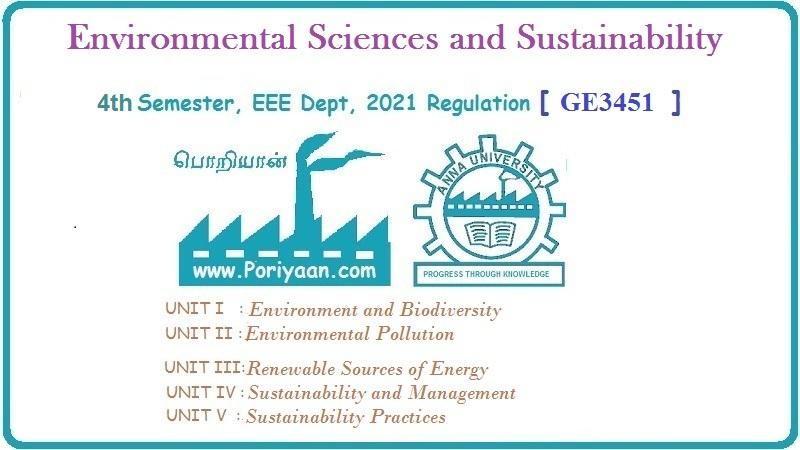Environmental Sciences and Sustainability: Unit V: Sustainability Practices
Green Engineering
Processes, Principles, Cradle to Cradle Concept
• Green Engineering can be defined as environmentally conscious attitudes, values and principles, combined with science, technology and engineering practice, all directed toward improving local and global environmental quality.
Green Engineering
•
Green engineering is the design, commercialization and use of processes and
products in a way that reduces pollution, promotes sustainability and minimizes
risk to human health and the environment without sacrificing economic viability
and efficiency.
•
Green Engineering can be defined as environmentally conscious attitudes, values
and principles, combined with science, technology and engineering practice, all
directed toward improving local and global environmental quality.
•
Green engineering utilizes engineering processes and methods that minimize
pollution, improve a business' sustainability and decrease the potential for
health issues caused by unsafe manufacturing and design methods.
•
Green engineering embraces the concept that decisions to protect human health
and the environment can have the greatest impact and cost-effectiveness when
applied early, in the design and development phase of a process or product.
•
Green Engineering is necessarily interdisciplinary and therefore, is best
considered as a set of concepts which can be applied across engineering
disciplines.
1. Processes in Green Engineering
•
Engineers may use many processes when green engineering, including :
1.
Waste reduction :
•
Many commercial processes, such as manufacturing and shipping products, may
waste energy through inefficient manufacturing and delivery methods.
•
Green engineering seeks ways to minimize this waste, including finding new fuel
methods and minimizing unnecessary production steps that needlessly use energy.
2.
Materials management:
•
Materials management entails finding better and safer materials for diverse
engineering purposes, particularly in product design and manufacturing.
•
Engineers may identify new and safer materials or invent options to integrate
into their plans and find better and more efficient production methods.
3.
Pollution prevention :
•
Pollution prevention focuses on identifying a company's pollution sources and
minimizing their waste.
•
Engineers may identify why pollution occurs, find processing methods that
decrease its spread, integrate newer and cleaner techniques and enhance
manufacturing and delivery cleanliness.
4.
Product enhancement:
•
Green engineers seek to improve the products or services they're engineering
while making them safer for the environment.
•
This process may include finding alternate energy sources that work better than
traditional options or identifying greener and more efficient manufacturing
materials and methods.
2. Principles of Green Engineering
1.
Inherent Rather Than Circumstantial : Designers need to
strive to ensure that all materials and energy inputs and outputs are as
inherently non-hazardous as possible.
2.
Prevention Instead of Treatment : It is better to
prevent waste than to treat or clean up waste after it is formed.
3.
Design for Separation : Separation and purification
operations should be designed to minimize energy consumption and materials use.
4.
Maximize Efficiency : Products, processes and systems should
be designed to maximize mass, energy, space and time efficiency.
5.
Output-Pulled Versus Input-Pushed : Products, processes
and systems should be “output pulled” rather than “input pushed” through the
use of energy and materials.
6.
Conserve Complexity : Embedded entropy and complexity must be
viewed as an investment when making design choices on recycle, reuse or
beneficial disposition.
7.
Durability Rather Than Immortality : Targeted durability,
not immortality, should be a design goal.
8.
Meet Need, Minimize Excess : Design for unnecessary
capacity or capability (e.g., “one size fits all”) solutions should be
considered a design flaw.
9.
Minimize Material Diversity : Material diversity in
multicomponent products should be minimized to promote disassembly and value
retention.
10.
Integrate Material and Energy Flows : Design of products,
processes and systems must include integration and interconnectivity with
available energy and materials flows.
11.
Design for Commercial Afterlife : Products, processes and
systems should be designed for performance in a commercial afterlife.
12.
Renewable Rather Than Depleting : Material and energy
inputs should be renewable rather than depleting.
3. Cradle to Cradle Concept
•
Cradle-to-cradle (C2C) is a way of designing products or processes that work
more like natural systems.
•
Cradle-to-cradle is a term used in life-cycle analysis to describe a material
or product that is recycled into a new product at the end of its life, so that
ultimately there is no waste. Zero waste, Zero trash, Zero litter, Zero
garbage, Nothing to throw away.
•
Cradle to Cradle design refers to a production process where products are
developed for closed-loop systems in which every output ingredient is safe and
beneficial - either to biodegrade naturally and restore the soil (called a
biological nutrient) or to be fully recycled into high-quality materials for
subsequent product generations (called a technical nutrient).
•
C2C design method is intended to replace a make-take-dispose approach which
begins with new raw materials mined from the earth and ends with piles of
garbage.
•
C2C is used to minimise the environmental impact of products by employing
sustainable production, operation and disposal practices and aims to
incorporate social responsibility into product development.
Environmental Sciences and Sustainability: Unit V: Sustainability Practices : Tag: : Processes, Principles, Cradle to Cradle Concept - Green Engineering
Related Topics
Related Subjects
Environmental Sciences and Sustainability
GE3451 ESS 4th Semester | 2021 Regulation | 4th Semester EEE Dept 2021 Regulation
